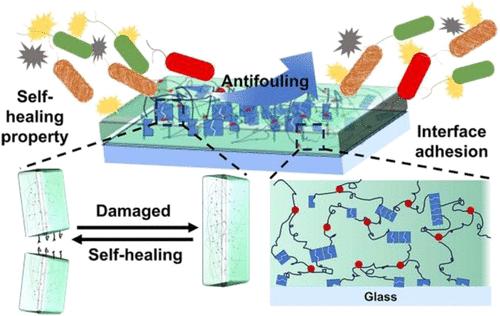海洋光学窗高附着自愈仿生三臂防污涂料
IF 8.2
2区 材料科学
Q1 MATERIALS SCIENCE, MULTIDISCIPLINARY
引用次数: 0
摘要
高透明度和耐用的防污表面对船舶应用至关重要。然而,实现一种既具有防污性能又具有高透光性的持久船舶涂层仍然是一个重大挑战。在这项研究中,我们提出了一种具有独特三臂结构的新型高粘附性、自修复的光滑液体注入多孔表面(SLIPS)防污涂层,该涂层由聚(二甲基硅氧烷)超分子聚合物设计而成,灵感来自天然蜘蛛网的设计。该结构利用了多强度动态氢键,包括一个四重氢键基序,2-脲基-4-嘧啶酮(UPy)单元。三臂结构通过提供额外的结合位点来增强粘附性,这些结合位点通过UPy单元的动态重排促进与界面基团的相互作用。重要的是,由于在侧链上放置了UPy单元,该涂层表现出增强的链迁移率,在水下环境中放置24小时后,自愈效率达到80%。这一性能大大高于在主链中使用UPy单元的涂料,后者的效率仅为30%。此外,制备的涂层不仅具有更高的透明度(~ 93.9%),而且还具有柔韧性、防污性能和抗生物污染性能。该设计策略为制造具有定制特性和复杂结构的多功能材料提供了一种有前途的解决方案。这些材料具有很强的自清洁和防污性能,适合在恶劣条件下使用,包括自清洁窗户和光学传感器保护等应用。本文章由计算机程序翻译,如有差异,请以英文原文为准。

Biomimetic Three-Arm Antifouling Coating with High Adhesion and Self-Healing Properties for Marine Optical Windows
High transparency and durable antifouling surfaces are crucial for Marine applications. However, achieving a long-lasting marine coating that combines both antifouling properties and high transmittance remains a significant challenge. In this study, we present a novel high-adhesion, self-healing Slippery Liquid-Infused Porous Surface (SLIPS) antifouling coating with a unique three-arm structure, designed from a poly(dimethylsiloxane) supramolecular polymer, inspired by the design of natural spider webs. This structure leverages multistrength dynamic hydrogen bonds, including a quadruple hydrogen bond motif, the 2-ureido-4-pyrimidinone (UPy) unit. The three-arm structure enhances adhesion by providing additional binding sites, which facilitate interactions with interfacial groups through the dynamic rearrangement of UPy units. Importantly, the coating exhibits enhanced chain mobility due to the placement of UPy units on the side chains, resulting in a self-healing efficiency of 80% after 24 h in underwater environments. This performance is substantially higher than that of coatings with UPy units in the main chain, which achieve only 30% efficiency. Furthermore, the prepared coating not only exhibited improved transparency (∼93.9%) but also demonstrated flexibility, antifouling properties, and resistance to biological contamination. The design strategy presents a promising solution for manufacturing multifunctional materials with tailored features and intricate structures. These materials demonstrate strong self-cleaning and antifouling properties, suitable for use in harsh conditions, including applications like self-cleaning windows and optical sensor protection.
求助全文
通过发布文献求助,成功后即可免费获取论文全文。
去求助
来源期刊

ACS Applied Materials & Interfaces
工程技术-材料科学:综合
CiteScore
16.00
自引率
6.30%
发文量
4978
审稿时长
1.8 months
期刊介绍:
ACS Applied Materials & Interfaces is a leading interdisciplinary journal that brings together chemists, engineers, physicists, and biologists to explore the development and utilization of newly-discovered materials and interfacial processes for specific applications. Our journal has experienced remarkable growth since its establishment in 2009, both in terms of the number of articles published and the impact of the research showcased. We are proud to foster a truly global community, with the majority of published articles originating from outside the United States, reflecting the rapid growth of applied research worldwide.
 求助内容:
求助内容: 应助结果提醒方式:
应助结果提醒方式:


